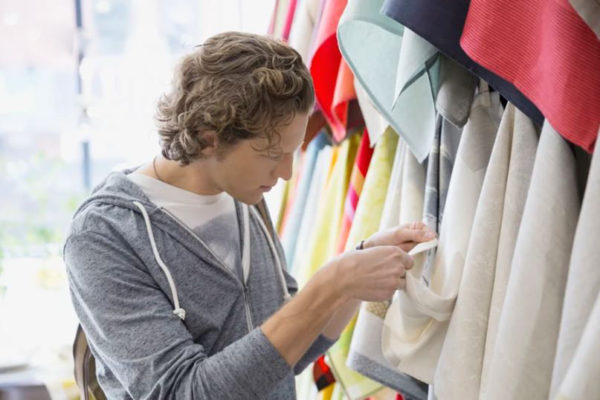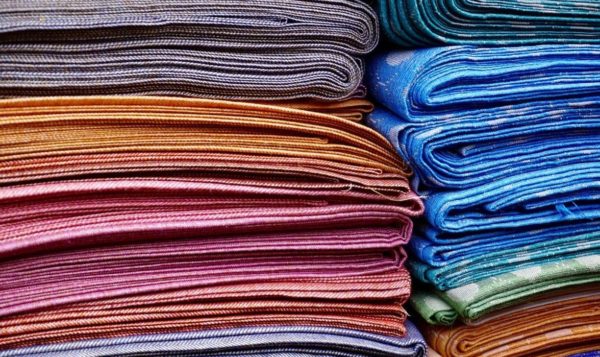
If you’ve read our Fashion Designer’s Ultimate Guide to Shopping the Market, you already know that shopping the market is a crucial part of the designer-entrepreneur’s job… and market research is a never-ending process! The fashion industry is changing, and with new technologies and methods of production arising, there’s always something new. It’s up to you, as a fashion entrepreneur, to stay on top of the trends, and that includes fabrics.
Once you’ve reached the stage of choosing fabrics and contacting fabric suppliers, you need to be on top of your game, knowing every little detail about what you’re looking for… otherwise, what you get might not be what you expect!
Here’s a checklist of every detail you need to know before dialing up your fabric dealer:
What the fabric is made of
In simple terms, we mean fiber content. Look at the label on your shirt or jeans – it will say something like “90% cotton, 10% nylon”. This is the fiber content – it’s the measure of different raw materials that make up the yarn to create a woven, non-woven or knit to make the fabric. It is important to know what fiber content you desire for your fabric, because it affects nearly everything about the finished garment, from quality and comfort to what it’s used for and how well it will sell in stores.
When you need the fabric
Unfortunately, you can’t assume that the materials you want will be ready for when you need them in this business. You’ll need to ensure that you allow for lead-time, the period of time between when you place the fabric order and when you actually need them in house (in other words, don’t order your fabric the day before!!!). The more lead-time you can plan for, the better because you’ll have more options to choose from at a lower cost. Ensure that you ask and clearly communicate your timelines with your fabric supplier to avoids delays or extra costs!
Continuity & Availability
Will you be able to re-order the fabric when stock runs low? Many fabric stores buy the end of the roll lots from mills and other sources, and that’s the end of it! Let’s say you buy some fabric for sampling and making prototypes. In the window between collecting orders and preparing to fulfill those orders in bulk, will the store still have it?
How much fabric you need
Knowing how much fabric you need is the first step, but it is not uncommon to run into minimums. Just like it sounds, a minimum is the smallest amount of fabric that you can buy from a factory to place an order, usually measured in yards. Some places have small minimums, while others may require you to purchase several hundred yards of fabric to place an order, so do your research!

Desired fabric weight
The weight of a fabric, generally measured in ounces by the square meter or yard or grams per square meter. Fabric weight determines a lot about the fabric and the garment it will be made into, from quality to care type, and beyond… so choose wisely! Different fabric weights are best suited for different types of garments – for example, you will probably prefer a light-weight or top-weight fabric for a spring blouse. Check out this cool blog post to get more familiar with fabric weights!
Desired fabric width
Just like with determining the length of the fabric you need, you’ll need to know your desired fabric width. An important note: the width of fabric can vary up to an inch or more depending on where you measure it along the goods, therefore widths are often quoted in two numbers to allow for the variance, such as 35/36” or 58/60”. The wider the goods the better utilization you get, because you can make more items from the cut! For apparel, fabrics with 60” widths are the most desirable for cost-effectiveness.
The fabric’s end-use
While this may seem redundant, knowing the fabric’s intended use and communicating this to the fabric supplier is crucial. Based on the intended end use, the fabric supplier can advise you about what choices may be best suited for your designs – for example, children’s wear will need durable fabric to avoid wear and tear, whereas a wedding dress may need airy, delicate fabrics.
If you’re new to fashion, you might not have thought you’d need all of this information. However, without supplying all of this to your fabric supplier, they will not be able to best assist you in shopping the fabric market – so do yourself a favor and prepare this information ahead of time, and prevent mishaps and headaches in the long run!
What are your favorite fabric suppliers? What makes them so special to you? Share them with your fellow Silaye community!
P.S. Do you need help working through and need some help honing in on your niche? Check out The ‘ Wil It Work?” Feasibility Package here.


